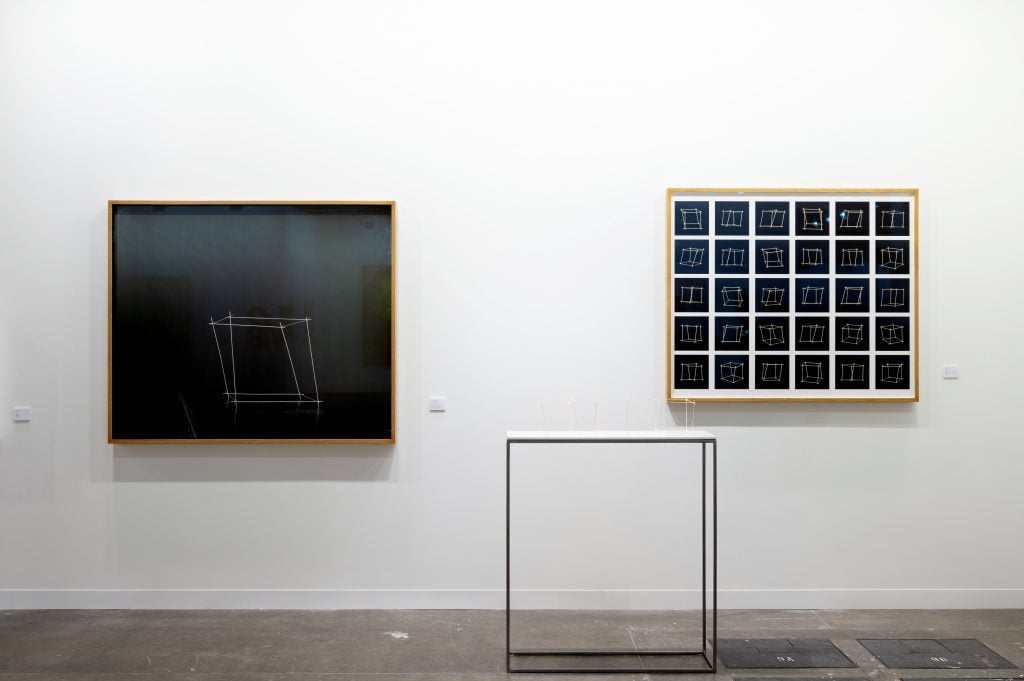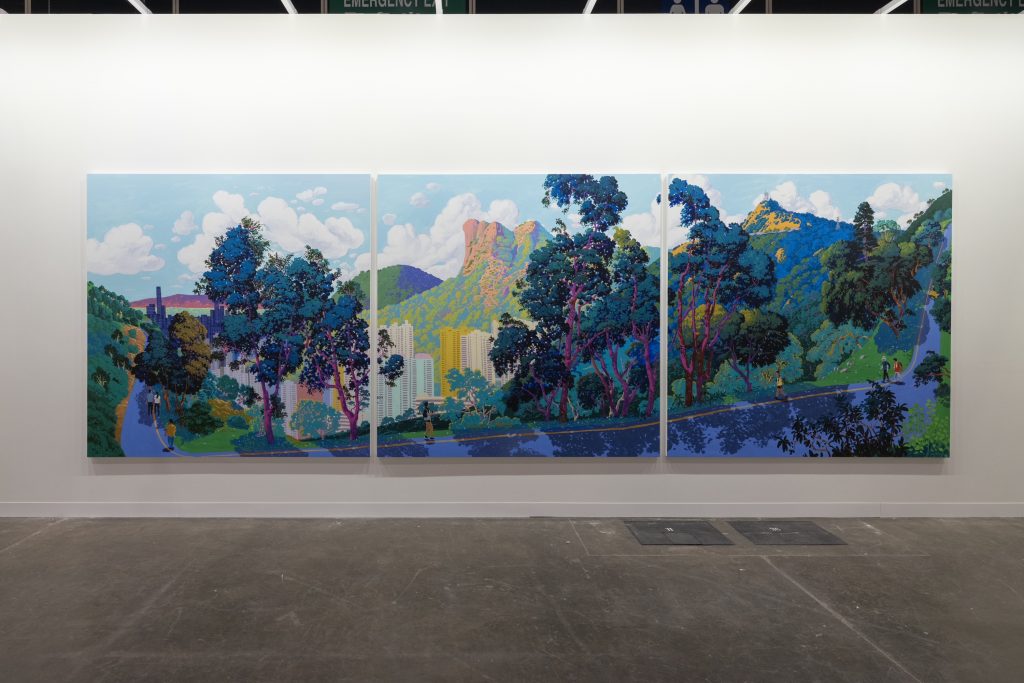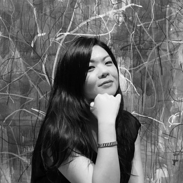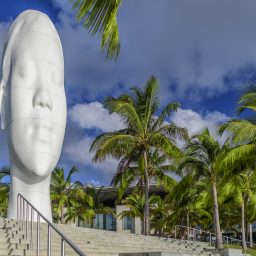A jovial atmosphere filled the Hong Kong Exhibition Centre this week as well-dressed art aficionados and gallerists with colorful face masks greeted each other as if they were long-lost friends.
Such was the sense at the opening of Hong Kong Spotlight by Art Basel, the first in-person event by the Swiss mega-fair company in 2020. Held in collaboration with Fine Art Asia, a homegrown fair focused on fine art and antiquities, Hong Kong Spotlight was described as a “mini-mini” version of Art Basel Hong Kong, which normally hosts more than 200 galleries.
Art Basel, which painfully had to cancel all its international fairs this year, presented 22 galleries with spaces in Hong Kong for the event, which was held alongside auctions headlined by Christie’s and the first collaboration between Phillips and Poly Auction Hong Kong.
“Fortunate” was the word that many fair-goers and gallerists used to describe their feelings about the five-day fair. Compared to many places in the world, Hong Kong has done a decent job with the pandemic, thanks to citizens’ acute awareness, universal mask-wearing in public places, and stringent social-distancing measures. It was even more fortunate that the fair, which closed on Monday, narrowly escaped the fate of cancellation: the local government announced the very day that it closed that it would further tighten social-distancing measures amid yet another surge.
(The latest wave, known as the “dance club cluster,” has been tied to a group of wealthy students at ballroom dance classes. Some gallerists at the fair expressed concerns about the development, especially as some VIPS cancelled their fair reservations.)
“In the past, we have said that we got tired of art fairs. But this time I feel that we are very lucky to have a physical fair presence in Hong Kong,” said a spirited Henrietta Tsui-Leung, founder of Galerie Ora-Ora. “I enjoyed talking to everyone. I’ve been missing this vibe.”

Edouard Malingue Gallery’s booth at the fair. Image courtesy of Edouard Malingue Gallery. Photo by Felix Wong.
Safety First
Fine Art Asia, which postponed its usual October slot to November, approached Art Basel for the collaboration. The result was a focused showcase of Hong Kong galleries meant to appeal to local buyers, rather than an international clientele.
Although there has been some speculation that Art Basel may be looking to stage additional smaller events, Angelle Siyang-Le, the project lead on Hong Kong Spotlight and Art Basel’s regional head of gallery relations in Asia, said it was organized as a one-off event to support the local art market.
“People like to come to fairs not just to buy and sell, but also to create new relationships,” Siyang-Le said. “Although there’s a significant increase in sales online, physical events cannot be replaced.”
Art Basel applied stringent crowd-control measures. The event was by-invitation only, and galleries were given only around two dozen invitations to send out. Pre-registration was a must, and the site’s capacity was capped at 30 percent. Visitors’ temperatures were taken and each person was required to sign a health declaration form. Face masks were mandatory: gallery employees were told not to remove their masks even for a sip of water. Staffers also roamed the fairgrounds holding signs to remind visitors to maintain three feet apart.
Although it was a comfortable environment, dealers eager to sell had limited opportunities. And while booth fees were half the cost of a usual Art Basel stand, some gallerists said fair organizers did not do enough to promote the event. For her part, Siyang-Le said safety was the top priority.

An installation view of Exit Gallery’s booth at the fair. Courtesy Exit Gallery.
Selling Art to the Locals
Artworks at varying price points were on sale at the fair, from five to six figures in US dollars. Smaller-priced items sold more easily, according to some dealers.
The most talked-about booth was Gallery Exit’s, which presented a solo exhibition of Hong Kong artist Stephen Wong Chun Hei’s colorful landscape paintings inspired by hiking, one of the city’s most popular weekend activities.
Priced between $5,000 and tens of thousands of dollars, sales were strong, said gallery director Anthony Tao, noting that galleries in Hong Kong have been operating as usual. Having a fair under the Art Basel brand in Hong Kong sent a message to the world that the market in Asia is still going strong, he added.
De Sarthe Gallery showed new works by Hong Kong artist Andrew Luk and works by Zhong Wei from Beijing, priced between $5,000 and $20,000. Gallery director Willem Molesworth said sales exceeded his expectations and noted, as did other dealers, that he was surprised to have met and sold works to local collectors who are usually not the focus of Art Basel’s bigger Hong Kong Fair. Another local gallery, 10 Chancery Lane sold works by Laurent Martin “Lo” priced from €5,500 to €28,000.
Some international galleries that have outposts in Hong Kong were also present. Lehmann Maupin sold three works from Lee Bul’s “Perdu” series to private collections in Hong Kong, the US, and Asia for a combined total of more than $500,000. Axel Vervoordt Gallery presented works by Japanese artist Yuko Nasaka priced at €18,000 to €270,000. At least four pieces sold on the first day of the fair.
Works by Doug Aitken and Chinese artist Wang Yuyang were on show at Massimo De Carlo’s booth, priced between $50,000 and $350,000. Claudia Albertini, director of the Hong Kong outpost of the gallery, said being able to participate in a physical fair finally gave the gallery “a chance to show artworks that deserved to be seen in the flesh.”
While some dealers expressed hope for another edition of the event next year, others said the focus needed to remain on Art Basel. Zheng Lin, founder of Tang Contemporary Art, which presented Zhu Jinshi and Zhao Zhao, said the show remained the most important in Asia.
“Hong Kong, without Art Basel, has little impact,” said Zheng, who flew in from Shanghai after briefly attending ART021 and West Bund, and completed a 14-day quarantine to attend Hong Kong Spotlight.
“We can only do what we can online,” Zheng said. “But to buy art, it still needs to be done face-to-face.”









